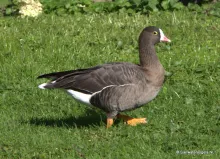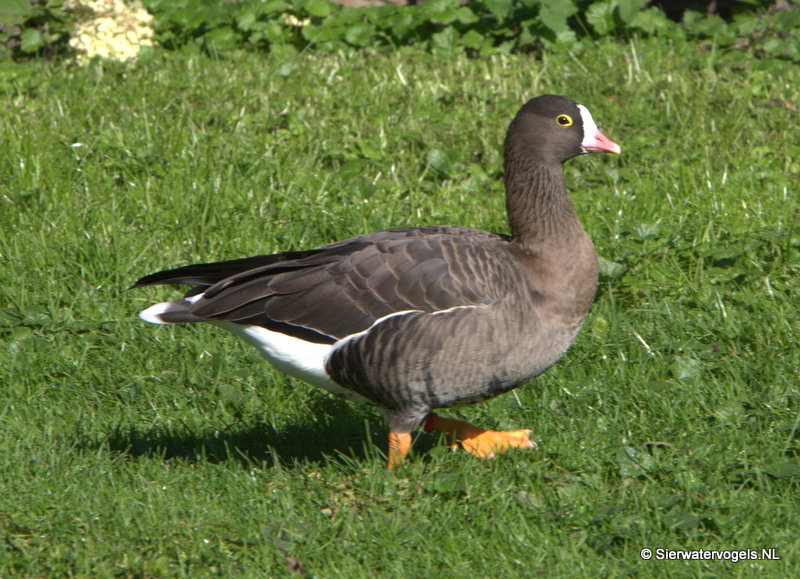
Lesser White-fronted Goose (Anser erythropus)
Species name
- Dutch name:
- Dwerggans of Goudooggans
- English name:
- Lesser White-fronted Goose
- German name:
- Zwerggans
- French name:
- Oie naine
- Scientific name:
- Anser erythropus
Scientific classification
- Order:
- Anseriformes
- Family:
- Anatidae
- Onderfamilie:
- Anserinae
- Genus:
- Anser
Description
- Description:
Male:
Small, grey-brown goose. White patch at base of pink bill. Black belly patches. Yellow eye-ring at close rangeFemale:
Identical as Male but smaller easy to tell apart when pairdJuvenile:
lacks pale eye-ring. Difficult to distinguish in flight .
Standard Measurements
- Body Length (cm):
- The male (drake) of the Lesser White-fronted Goose measures approximately 53–66 centimeters. The female measures approximately 53–66 centimeters.
- Body Weight (grams):
- The male will weight about 1440-2300 gram. The female will weight about 1300-2150 gram.
The weight is notoriously variable and can only be used as indication!
- Note:
Lesser white-fronted geese are hardy, easily managed and attractive. They prefer large lakes with good-quality water. They may be kept as pairs, or in small groups if sufficient grass is available. These geese are not aggressive, and may be kept with small ducks. Aggression towards humans reported from one pair. Good grazing will provide most of their food, also feed wheat, pellets, greenfood, bread: plenty of green food should be available.
These geese are relatively easy to breed. Eggs laid from end of April to June, in quiet spots such as in long grass, under bushes or on islands; they will also use nest boxes. Parent rearing is usually successful; goslings require shelter from hot sun and a dry place for shelter from prolonged rain (may need to be driven into a dry place for the night).
Pair-bonds are strong once formed, but unmated birds may pair with all other Anser spp., as well as the smaller Branta spp.; these geese are best maintained apart or with species which are not closely related.
- Breeding:
- The female Lesser White-fronted Goose usually lays from 4-6 pale yellow-white eggs and incubates them for 25-28 days.
- Artificial incubating:
The ideal relative humidity for incubating most waterfowl eggs is 55% (ground nesters) and 40% (cavity nesters). The temperature is usually 37.4°C. Set ventilation as recommended by the incubator manufacturer. Eggs must be turned, either automatically or by hand, a minimum of 4 times a day. As the duckling develops there is a loss of water from the egg and the air sac gets bigger. In normal development of an egg with a 25-28 days incubation, the air sac occupies about a third of it three days earlier. Cleanliness is vital and ideally eggs should be moved to a separate hatcher at this point, where the humidity should be increased to 65% and even higher once they have pipped internally.
- Bird banding:
- Recommended closed leg band ring size for the Lesser White-fronted Goose is 14 mm.The leg band ring can only be applied on a young goose at around 12 days old.
- It doesn't matter what leg that you band, but it's good to have a consistent system. Suggested: Left leg = Female, Right leg = Male
- Rearingfeed:
-
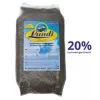
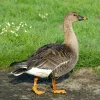

Floatable special rearing feed for all types of aquatic ornamental fowl - especially for the cultivation of trees as well as greening ducks.
This well-balanced complete feed with 20% protein content convinces above all by its good compatibility and forms the basis for visibly healthy growth from day one.
Made exclusively from wholesome and selected raw materials, Lundi Micro Regular is also ideally suited for the year-round feeding of waterfowl.
- Maintenance food:
-



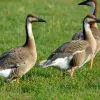

Lundi Regular with a protein content of 20%, valuable Spirulina and high-quality by-products is optimally balanced in its composition maintenance food for water ornamental fowl of all kinds. Especially green teal and Whistling ducks that are not dependent on a very high protein content, are well supplied.
Lundi Regular contains all the minerals and vitamins in full form that are important for the animals. Therefore also suitable as breeding food.
- Regulation:
- Europese soort
- Regulation:
The lesser white-fronted goose is considered an endangered species, but there are programmes to reintroduce animals into the wild to strengthen the population. Additionally it is one of the species to which the Agreement on the Conservation of African-Eurasian Migratory Waterbirds (AEWA) applies.
